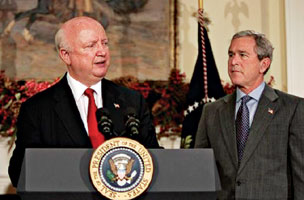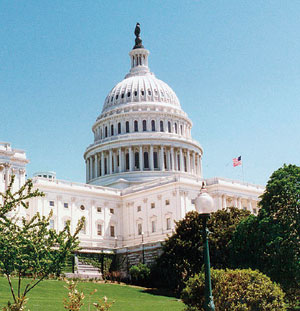OUTLOOK 2005: United States
Washington in 2005
Congress likely to differ with Bush on US energy policy
John McCaughey, Contributing Editor, Washington
A second term, the political scientists instruct us, is often referred to as “the legacy term,” in which a US President seeks one (or, with good luck, several) achievements that will define his role in history. This is all very commendable, to be sure, but the question is whether the buoyant (although not, of course, triumphal) President George W. Bush can deliver.
In energy, the signs are not encouraging. Washington energy lobbyists and other observers fear that the President will have as little success with his energy bill and other goals (such as opening up the Arctic National Wildlife Refuge to drilling) as he did in his first term. That is to say, no success. They fear that he will be preoccupied with spending his political capital on big-ticket items like Social Security, tax simplification and tort law reform.
 |
Despite his oil and gas background, US President George W. Bush does not seem likely to invest too much of his hard-earned political capital on energy policy initiatives during the second term.
|
|
First term’s record. Various energy policy bills collapsed several times in the last three years under the sheer weight of legislative pork that was piled upon them (no special interests were left behind). Energy bills were big, clumsy, ugly and dead on arrival. Furthermore, ANWR drilling could never overcome the skilled opposition of the “enviros.”
Nor, indeed, could it overcome the opposition from now-deposed Senate Minority Leader Tom Daschle (Democrat – South Dakota), under whom the Senate became known as “the Dead Zone.” Daschle’s motto was said to have been, “If it has a pulse, filibuster it.” So, in that manner, he buried every energy bill. In the post-election world, the House Republicans have the votes to pass almost any legislation they like, but in the Senate, the Republicans still do not have the votes to overturn a filibuster. Previous, comprehensive energy policy bills have also stalled on the issue of whether to give MTBE manufacturers liability protection. MTBE is a gasoline additive that is said to contaminate groundwater.
In any case, the politics of energy tend to be regional, rather than partisan. The November election did change that a bit. It’s still regional, but now it’s becoming partisan.
The new Congress. This time around, Republicans are contemplating breaking any energy bill into smaller, discrete packages – something that they previously refused to do. At least this strategy offers more hope of success than the previous Fat Momma, single-bill strategy. Republicans also want to attach the ANWR vote to a spending bill, which cannot be filibustered. But little is expected to happen before March. Meanwhile Conoco-Phillips is the latest major to pull out (for reasons upon which spokesmen were vague) of Arctic Power, the ANWR lobbying group. Most of that group’s money will now have to come from the State of Alaska.
President Bush’s problems in the 109th Congress are not with the Democrats. Dismayed and disarrayed by the indisputable defeat of Sen. John Kerry (Democrat-Massachusetts), which featured his ludicrous campaign promises of energy independence for the US, Democrats are not, for the moment, a force to be reckoned with on Capitol Hill. On the Hill, Republicans hold small, but firm, majorities in both chambers.
Democrats are dithering between moving sharply to the Left under Northeasterners like former presidential candidate Howard “The Scream” Dean (Democrat – Vermont) or triangulating to a centrist, Clintonesque pose. Their future direction will not be indicated until Feb. 10, when the Democratic National Committee meets to elect a chairman (and other party leadership posts) whom, they pray, may lead them out of the wilderness. For the moment, though, the mood on the Hill is very far from bi-partisan. Staffers from both sides of the aisle, long accustomed to setting aside for the moment their political differences to go to lunch together, no longer do so.
Bush’s second-term problem is far more political. The post-election euphoria may last for far less time than he had hoped, and his Lame Duck presidency may set in within six months, rather than (as had been expected at the White House) arriving after the 2006 congressional mid-term elections.
Emboldened by the November election, Republicans on the Hill are feeling feisty. They are a lot less willing to kowtow to the White House than they were during the first term, when they depended upon riding on Bush’s coattails to re-election. Some of them may even be “wannabe” presidents at next election time. Now, they realize, Bush will be focused on The Legacy, so it is unnecessary for them to go along with the White House all the time. They can come out of the closet and shape legislation that they want. Inevitably, this will bring about strains and fractures within the Republican majority.
Big energy companies can certainly count themselves as beneficiaries of the Bush victory – although less because of the Bush victory and more from the fact that Kerry did not win. Old King Coal certainly cheered: The days immediately after the election saw $600 million added to the market value of the four largest coal companies. One coal group spokesman had described Kerry’s emissions-reduction platform as “a death-knell for the coal industry.” Correspondingly, alternative energy companies (such as fuel cell developers) took a post-election pounding in the stock markets.
Factors affecting policy. Real problems from 2004 continue into 2005. In February, the Kyoto Protocol on climate change takes effect for participating nations; notable exceptions include the US. Even greenies realize that the US is never going to ratify this scientifically dubious and economically ruinous piece of global, regulatory confectionery. For Heaven’s sake, even John Kerry opposes it. But the issue of climate change is unlikely to go away in 2005, and it could throw a “spanner” into any legislative energy debate.
Contrary to the bombast of the over-heated election campaign, the US economy is not in bad shape. Inflation-adjusted gross domestic product (GDP) growth is up about 4%, annually, over the last two years, or a half-percentage point better than the long-term average. But there is no shortage of threats – notably the price of oil and the falling dollar.
Oil prices are the biggest worry, not so much because of OPEC greed, but because of the long-running debate on when, exactly, global oil production will irreversibly peak. A pessimistic school argues that this could be as soon as within the next 10 years, with catastrophic consequences if mitigation measures are not put in train immediately (coal, nuclear and oil shale alternatives are most often mentioned; wind power and renewables just won’t cut it).
OPEC (notably Saudi Arabia) beats a contrary, optimistic drum on reserves and production potential, but nobody with intelligence has believed OPEC production or reserves numbers for decades past. A forthcoming DOE study on global oil production peaking may throw light on the contentious topic, if the agency ever screws up the nerve to release it. Peaking aside, if oil prices stay at their present level (nudging $50/bbl), many economists predict a recession in 2005.
Meanwhile, US natural gas production – important because it fuels much of the new generation of electricity generating plants, as well as providing industrial feedstock and firing vital heating for commercial and residential sectors in winter – is in steady decline. Prices have gone up sharply. The old import standby, Canada, has its own problems, and has less and less gas to export. And US independent gas producers, hampered by constricted access to federal lands, have been unable to move the needle on supply, try as they might.
LNG’s role. For a period during 2004, LNG was touted as the solution to the problem, or at least a palliative. There are enormous gas reserves around the world, so put the LNG into huge tankers and ship it to an eager America. This is all right in theory but, of course, the liquefaction plants at source and the regasification terminals in the US (as well as the tankers themselves), require enormous capital investments and take a lot of time to build. Additionally, the US is not the only market for LNG. Demand is heavy in Europe and Asia.
Worse, environmentalists and NIMBYists in the US are fiercely opposed to new regasification terminals (only four operate at the present time), most especially if the terminals are anywhere close to populated areas. At Christmas time last year, a 12-month-in-the-making report from the Sandia National Laboratory gave the enviros and the NIMBYists new ammunition. The report painted a lurid picture of what could happen (skin-peeling burns suffered a mile away) if terrorists successfully hit a tanker with bomb-laden boats, rocket-propelled grenades or kamikaze aircraft. And that was only the sanitized, unclassified version from the scientifically well-regarded Sandia lab. Presumably, the larger, classified report was even scarier.
Curiously, the report attracted minimal press attention, seemingly not covered at all by The Wall Street Journal (perhaps the LNG reporter was on paternity leave, suggested one wag). Equally, the relevant agencies – DOE and the Federal Energy Regulatory Commission (FERC) – issued brief dismissive responses, suggesting that this was all old stuff, that protections were in place, with nothing to worry about. So, go away and have a nice cup of tea… It is doubtful, however, that LNG tanker insurers will take such a complacent view.
The DOE mess. If George W. Bush (a Texas oilman for a time, and so is said to be interested in energy) can tear himself away from more pressing issues in his new term, he might do worse than to reform DOE. The department is a shambling behemoth that, for years, has had a succession of Energy secretaries of conspicuous incompetence and no background in energy. Most of the department’s budget, nowadays, goes to nuclear weapons and materials matters, a task that would be far better allocated to the Defense Department. Similarly, DOE’s environmental clean-up work, which the department has hopelessly mishandled, would be better off if given to the Army Corps of Engineers, which understands these things better.
Bush has nominated Samuel W. Bodman as his new Energy Secretary. Bodman’s background includes tenures as chemistry professor at MIT, venture capitalist and deputy secretary at the Departments of Commerce and the Treasury. He is said to be a good manager. He will need those skills, and many more, to rebuild the shambles into which DOE has degenerated.
 |
Speaking to the media during the announcement of his nomination as DOE secretary by President Bush, Samuel Bodman stressed his early background as a chemical engineering professor at MIT, followed later by 14 years at Cabot Corp.
|
|
Even the Energy Information Administration (a subset of DOE) has been not merely wrong, but embarrassingly wrong with its natural gas supply and pricing forecasts in recent years. In energy matters, the Interior Department has scarcely had a better record. But, as is usual in Washington, bureaucrats are rarely held accountable for their blunders. The unfortunate Bodman may discover that being named secretary of Energy is about as useful as being named ambassador to Lower Slobovia.
A bit of optimism. But, wait, all is not gloom in the 2005 energy outlook. High crude prices are a bonanza for oil-producing states, such as Alaska, Wyoming and New Mexico. These three states are likely to pull in $4.5 billion in royalties and taxes from oil and gas production in fiscal 2004, up a robust 25% from the previous fiscal year. The Bureau of Land Management (part of the Interior Department) admits, with only slightly shame-faced pride, that it is collecting more than $1 billion a year in royalties and rental fees from producers on federal lands. Part of the cash is shared with the states. Furthermore, assuming that oil and gas prices remain high, any uptick in offshore drilling activity on the Outer Continental Shelf in the Gulf of Mexico could have substantial, sweet rewards for the US federal government, in terms of extra royalties. Of course, this will depend on such fickle factors as rig availability and enough trained manpower to take care of every operator’s needs.
Skeptics wonder how long the boom will last. They point out that spendthrift politicians have, in previous booms, blown the money away like drunken sailors. The politicians and bureaucrats at state level promise not to do the same thing this time. But they can’t help admitting to a degree of satisfaction. It’s “pretty darn sweet,” says Buck McVeigh, director of economic analysis for the state of Wyoming. 
THE AUTHOR
|
 |
John McCaughey edits and publishes Energy Perspective, a Washington-based, fortnightly publication that features in-depth coverage of major energy topics. Mr. McCaughey has been a journalist during all his working life. He has written and edited for Irish newspapers, an international news agency, the London-based Financial Times and the US-based Energy Daily newsletter, and contributed to many other newspapers.
|
| |
|
|








